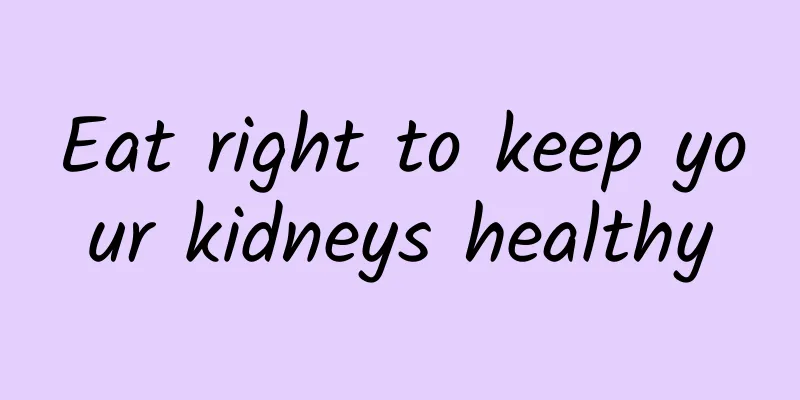Eat right to keep your kidneys healthy

|
Author: Li Wen, Ph.D., attending physician, Xuanwu Hospital, Capital Medical University Reviewer: Wang Changyuan, Chief Physician, Xuanwu Hospital, Capital Medical University Chronic kidney disease, often referred to as the "silent killer", refers to a disease caused by various reasons that causes abnormal kidney structure or function and has a history of more than 3 months, which seriously affects people's health. In recent years, the incidence of chronic kidney disease has increased year by year, and even younger and younger. An epidemiological study in my country showed that the prevalence of chronic kidney disease in people over 18 years old is as high as 10.8%, which seriously affects people's healthy life. Chronic kidney disease has early symptoms such as fatigue and increased nocturia. After entering the renal failure stage, symptoms such as heart failure, acid-base imbalance, anemia and central nervous system disorders may occur, seriously affecting the quality of life. Therefore, early and effective treatment of chronic kidney disease is particularly important for improving the quality of life and prognosis. Standardized nutritional therapy and dietary guidance are important components of managing patients with chronic kidney disease. Many patients with chronic kidney disease are often troubled by "eating". Insufficient intake will lead to malnutrition, but excessive intake will increase the burden on the kidneys and accelerate the deterioration of kidney function. Patients often ask: "What can I eat? What can't I eat? My kidneys are not good, do I need to supplement them?" Below we will share with you several dietary precautions that chronic kidney disease patients tend to ignore. Figure 1 Copyright image, no permission to reprint 1. Low-salt diet Salt is a necessary substance for various metabolic activities of the body, but excessive salt intake is associated with a variety of health problems. Salt intake has a significant risk relationship with the progression of chronic kidney disease in patients. Excessive salt intake can lead to high blood pressure, edema, etc. The "Dietary Guidelines for Chinese Residents (2022)" recommends a daily salt intake of 5 g for healthy adults. If the patient has edema and high blood pressure, the salt intake should be reduced to 2 to 3 g per day. So how do we know the salt content of food in daily life? Let's take a look at the salt content of common foods. Figure 2 Copyright image, no permission to reprint If we put 1 beer cap of salt in cooking every day, then we will consume about 6 g of salt, 1 salted duck egg is about 4 g of salt, and 5 ml of soy sauce is about 1 g of salt. In addition to the salt used for cooking, we often come into contact with some foods with high salt content in our lives, such as pickles, preserved eggs and sausages, etc., and we should reduce or avoid eating these foods. We should choose light cooking methods, such as steaming, boiling, stewing, braising, etc., use more spices such as onions, ginger, and garlic to enhance the flavor, appropriately improve the taste, and replace saltiness with sour, sweet, spicy, etc. In addition, a lot of salt will dissolve in the soup during the cooking process, so you should pay attention to drinking as little soup as possible. It is important to note that patients with chronic kidney disease should use low-sodium salt with caution! Low-sodium salt is made by adding a certain amount of potassium chloride and magnesium sulfate to ordinary salt. Compared with ordinary salt, the sodium chloride content of low-sodium salt is reduced, but the potassium chloride content is increased, which can easily lead to hyperkalemia and cause greater harm to patients. For patients who take diuretics for a long time, it is important to check the serum sodium level. If the blood sodium is low, the daily diet should be adjusted appropriately. 2. Low-protein diet The kidneys are the body's excretory organs, constantly excreting metabolic waste from the body. If you eat too much high-protein food, the waste produced during protein metabolism will increase significantly. In order to excrete these wastes, the kidneys have to "work hard", which will increase the burden on the kidneys, damage the structure and function of the kidneys, and lead to chronic kidney disease. Since a high-protein diet can lead to chronic kidney disease, shouldn’t the lower the protein intake, the better? The answer is no. Protein is an essential component for the normal functioning of human tissues and organs. Insufficient protein intake can lead to malnutrition, cachexia, etc., causing significant damage to the body and is not conducive to the treatment and management of kidney disease. So, how much protein is appropriate for the human body to consume every day? The specific amount of protein intake needs to be adjusted according to the different stages of chronic kidney disease. If diagnosed with chronic kidney disease stage 1 or 2, the protein intake should be appropriately reduced, and the daily intake should not exceed 0.8 g/kg; if it is chronic kidney disease stage 3, the daily protein intake should not exceed 0.6 g/kg. In other words, for a 60kg chronic kidney disease stage 1 or 2 patient, the daily protein intake should not exceed 48g; when the condition progresses to chronic kidney disease stage 3, the daily protein intake should not exceed 36g. The protein that the human body consumes every day mainly includes plant protein and animal protein. So should patients with chronic kidney disease consume plant protein or animal protein? The composition of animal protein amino acids is similar to that of the human body and is easily absorbed. Therefore, the intake of protein should be mainly animal protein, which should reach 50% to 70%. What foods are high-quality proteins? High-quality proteins include milk, eggs, lean meat, fish, chicken, etc. So how much of these high-quality proteins, such as meat, eggs, and milk, should patients with chronic kidney disease eat at each meal? Generally speaking, 1 liang (=50 g) of lean meat contains about 7 g of protein, 100 ml of milk contains about 3 g of protein, 2 egg whites contain about 7 g of protein, 2 liang (=100 g) of rice contains about 7 g of protein, 2 liang (=100 g) of steamed bread or noodles contains about 9 g of protein, and 200 g of vegetables/fruits contain about 1 g of protein. Patients with chronic kidney disease can estimate the total amount of protein they need to consume every day based on their weight, and then distribute it among the three meals. While taking in protein, pay attention to adding an appropriate amount of vegetables and fruits. Figure 3 Copyright image, no permission to reprint At the same time, we should pay attention to replenishing energy. Adequate energy supply can make full use of high-quality protein in the body, prevent the decomposition of body tissues caused by insufficient energy supply, and reduce the generation of endogenous nitrogen waste. In addition, in order to ensure that malnutrition does not occur when protein intake is restricted and to reduce the production of uremic toxins at the same time, compound α-ketoacid preparations should be supplemented under the guidance of a doctor. 3. Limit potassium intake Potassium is an important ion in the body, involved in metabolism and maintaining the contraction and relaxation of the heart. The kidney is the "back valve" of blood potassium. If potassium intake is high, the kidney will excrete more potassium; if potassium intake is low, the kidney will excrete less potassium. Under normal circumstances, if the kidney function is normal, hyperkalemia rarely occurs. However, after the kidney function declines, the regulatory ability of the kidney "valve" decreases, and hyperkalemia is particularly prone to occur. Therefore, patients with chronic kidney disease should try to avoid eating foods with high potassium content, such as bananas, oranges, potatoes, spinach, tomatoes, celery or peppers. If you want to eat vegetables with high potassium content, you should boil them in water and pour out the remaining cooking water. Winter melon, zucchini, pineapple and other fruits have low potassium content and can be eaten with confidence. 4. Drink water in moderation and measure your intake Water is an important nutrient for maintaining human health and helps produce urine to excrete metabolic waste. The Dietary Guidelines for Chinese Residents (2022) recommends a daily water intake of 1500-1700 ml. For patients with chronic kidney disease who have no edema and normal urine volume, the recommended daily water intake is 1000-2000 ml. For patients with chronic kidney disease who have edema and/or decreased urine volume, they need to plan their water intake every day, that is, plan their water intake based on daily urine volume and dialysis dehydration to avoid aggravating edema. The damaged kidney is "carrying a heavy load" every moment. Please do not add more burden to its "tired body". We need to adjust our eating habits scientifically to protect our kidneys. Eating right will make your kidneys healthier. [References] [1] Gao Xiang, Mei Changlin. Interpretation of the Guidelines for Early Screening, Diagnosis and Prevention of Chronic Kidney Disease (2022 Edition)[J]. Chinese Journal of Practical Internal Medicine, 2022, 42(9): 735-739. [2] Chinese Medical Association Nephrology Branch, Chinese Association of Integrated Traditional Chinese and Western Medicine Kidney Disease Professional Committee Nutritional Therapy Guidelines Expert Collaboration Group. Chinese Clinical Practice Guidelines for Nutritional Therapy of Chronic Kidney Disease (2021 Edition) [J]. Chinese Medical Journal, 2021, 101(8): 539-559. [3] Chinese Nutrition Society. Dietary Guidelines for Chinese Residents (2022)[M]. Beijing: People's Medical Publishing House, 2022. |
Recommend
Children cannot exercise after congenital heart disease surgery? The truth is...
"My child has undergone congenital heart dis...
Are there any side effects of caesarean section when you are old?
Giving birth to a child is a great thing. It can ...
How to do endometrial repair surgery
The endometrium is an important component of the ...
Can having a cold reduce the risk of COVID-19 infection? The truth is not necessarily that simple
Some studies in the past two years have found tha...
What to do with menstrual lower abdominal pain? Do these things
Menstruation is a physiological cycle. Women have...
What is the cause of the yellow and sticky leucorrhea?
Be careful if your leucorrhea is thick and yellow...
Wang Lixiang and Wang Guiqiang: Weighing Your Weight on World Obesity Day - "Preventing "Underweight" Weight Management Part 1"
Obesity is a common metabolic syndrome. The WHO h...
The culprit for “loss of voice” may not be the air conditioner, there may be a serious problem behind it!
Although the beginning of summer has passed, Chon...
Chinese medicine has a trick to relieve back and leg pain
In life, back and leg pain is a very common probl...
Why do women's palms and soles feel hot?
Some women may find that their palms and soles ar...
What should I do if chloasma appears on my face during menopause?
When women reach menopause, their hormones will f...
What to do if you have fever and sweat during menopause
If women may experience mental anxiety and depres...
Is surgery effective for treating ovarian cysts?
Ovarian cyst is a relatively common gynecological...
My girlfriend vomited because of stomach discomfort
Pregnancy is something that makes the whole famil...
I often feel tired. What’s going on?
Every day we always feel weak and tired, even if ...









